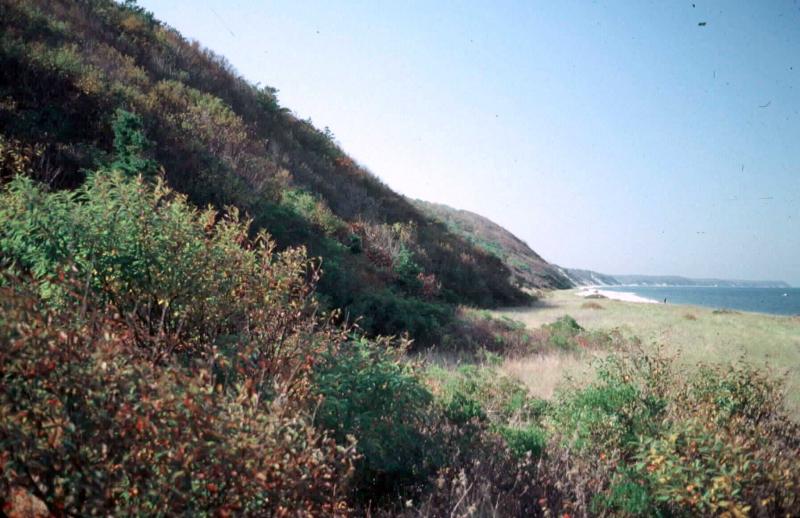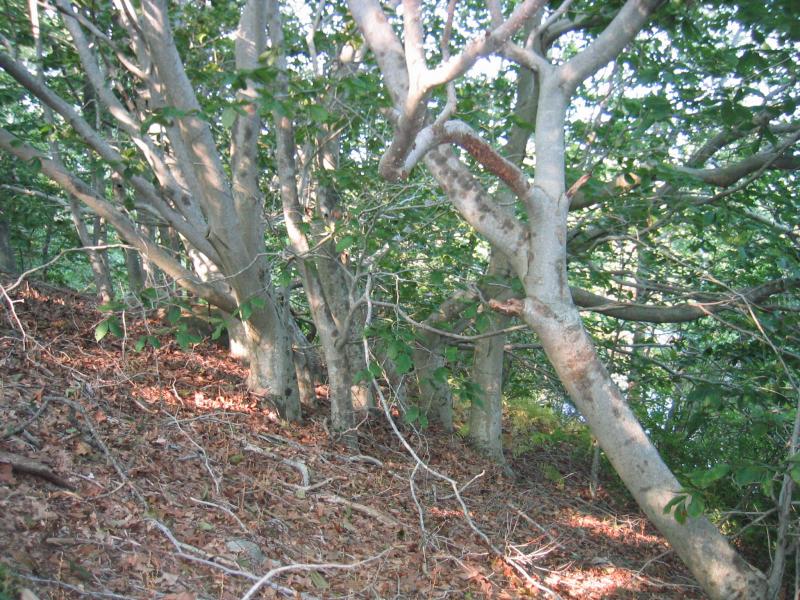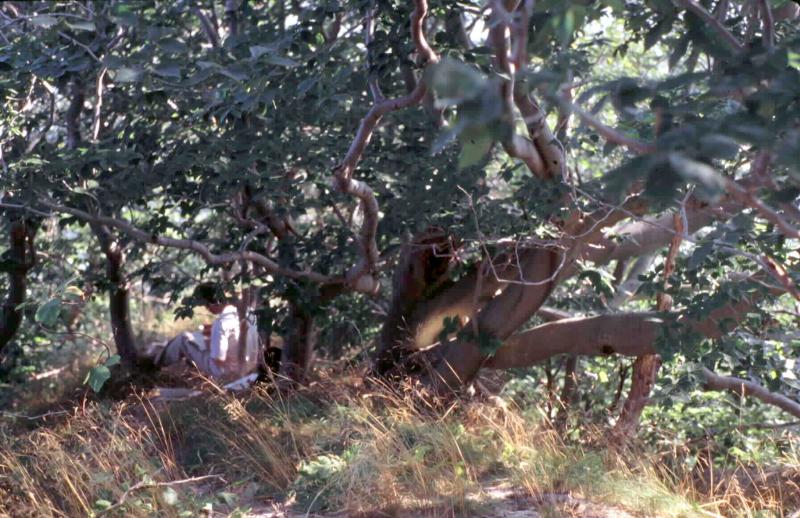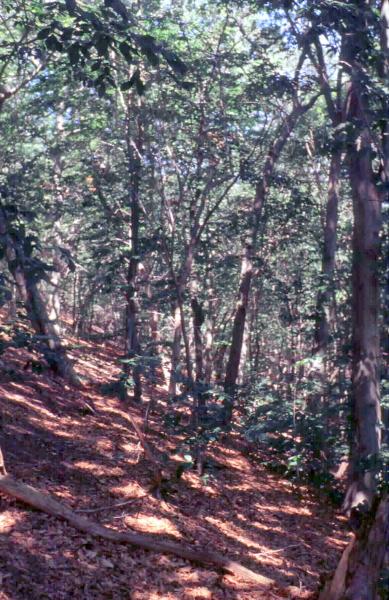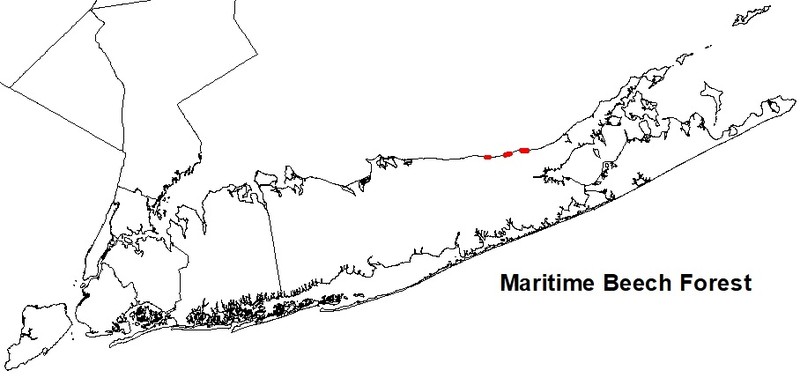Maritime Beech Forest
- System
- Terrestrial
- Subsystem
- Forested Uplands
- State Protection
- Not Listed
Not listed or protected by New York State.
- Federal Protection
- Not Listed
- State Conservation Status Rank
- S1
Critically Imperiled in New York - Especially vulnerable to disappearing from New York due to extreme rarity or other factors; typically 5 or fewer populations or locations in New York, very few individuals, very restricted range, very few remaining acres (or miles of stream), and/or very steep declines.
- Global Conservation Status Rank
- G2
Imperiled globally - At high risk of extinction due to rarity or other factors; typically 20 or fewer populations or locations in the world, very few individuals, very restricted range, few remaining acres (or miles of stream), and/or steep declines.
Summary
Did you know?
Beech by the beach! This natural community is a hardwood forest with American beech (Fagus grandifolia) dominant. It occurs on north-facing exposed bluffs adjacent to the beaches of the north shore of Long Island. The trees are sculpted by salt spray. They can occur contorted and stunted as the salt spray "prunes" them.
State Ranking Justification
There are very few occurrences of maritime beech forests in New York State. These forests only occur as narrow bands (strand forests) on steep, north facing bluffs and dunes on the north shore of Long Island. Less than five sites are known in the State. Only one of these sites has adequate protection.
Short-term Trends
The numbers and acreage of maritime beech forests in New York have declined in recent decades due to cultural displacements. Residential and commercial development, as well as trails, and roads through the natural community have led to a steady decrease in the size of this community.
Long-term Trends
The numbers and acreage of maritime beech forests in New York have declined from historical numbers. Settlement of the area and the resulting residential, agricultural, and commercial developments have led to this decline.
Conservation and Management
Threats
The threats to the maritime beech forest are many and varied. Possibly the greatest threat is an increase in trails and sand roads through the community created by hikers and/or off road vehicles (ORVs) that are used for access to adjacent beaches. The increased use of these trails and roads results in an increase in erosion thereby reducing bluff size and ultimately forest size. Trails and sand roads also act as conduits for invasive species. Deer browse is also a threat affecting regeneration of dominant canopy tree species. American beech (Fagus grandifolia) trees in this community are threatened by the following diseases: 1) Beech Bark Disease causes significant mortality and defect in American beech. The disease results when bark, attacked and altered by the beech scale (Cryptococcus fagisuga), is invaded and killed by fungi, primarily Nectria coccinea var. faginata and sometimes N. galligena (Houston and O'Brien 1983). This disease is common across New York State (NYS DEC); 2) Beech Leaf Disease was first discovered in 2012 from northeastern Ohio (Ewing et al. 2019). The disease was first observed in New York in 2018 in Chautauqua County and was found in Suffolk and Nassau counties in 2019 (NYS DEC). It has since spread throughout western, central, and southern NY (NYS DEC). The foliar nematode Litylenchus crenatae ssp. mcannii is responsible for beech leaf disease and is believed to be non-native in North America (Carta et al. 2020, Reed et al. 2020). Beech leaf disease can kill beech trees of all ages though younger trees appear to die more quickly (NYS DEC).
Conservation Strategies and Management Practices
Management activities should include establishing a natural buffer of coastal-oak forest inland. Reducing or eliminating use of beach access trails and sand roads, especially those that are perpendicular to bluff slope, to allow for revegetation. Monitoring exotic plant species noted in the surrounding landscape including bittersweet (Celastrus orbiculatus), multiflora rose (Rosa multiflora), honeysuckle (Lonicera japonica), Japonese barberry (Berberis thunbergii), and others.
Development and Mitigation Considerations
Soils are primarily sand in and around this community and the effect of clearing and construction on erosion must be considered during any development activities. Similarly, these soils are nutrient-poor and any soil enrichment activities (septic leach fields, fertilized lawns, etc.) have a high probability of altering community structure and function. The stunted American beech-dominated structure of this community is maintained by wind, salt spray, and natural dune movement. These factors need to be considered with any development plan.
Inventory Needs
Determine direction and rate of erosion of bluffs plus intensity and frequency of erosion events. Accurately map and refine the boundaries of this community and determine where it grades into other natural community types. Determine tree age and obtain more data on characteristic animals.
Research Needs
Research is needed to better define the composition of this community on Long Island. Collect sufficient plot data to support this classification.
Rare Species
Range
New York State Distribution
Maritime beech forests are currently known only from the town of Riverhead, Suffolk County, Long Island. Historically, they may have occurred along the north-facing coastal bluffs and back-dunes of Long Island in Suffolk and Nassau County.
Global Distribution
This community is restricted to maritime bluffs and backdunes dominated by American beech (Fagus grandifolia). It is naturally restricted by available habitat on Long Island, New York. This natural community is related to maritime oak-beech forests of Massachusetts, New York, and New Jersey, but differs in the striking dominance of American beech and the absence of many of the other characteristic species. There are fewer than five known examples of this natural community (NatureServe 2009).
Best Places to See
- Wildwood State Park (Suffolk County)
Identification Comments
General Description
Maritime beech forests are hardwood forests with American beech (Fagus grandifolia) dominant that usually occurs on north-facing exposed bluffs and the back portions of rolling dunes in well-drained fine sands. Black oak (Quercus velutina) and red maple (Acer rubrum) may be present at low density. Occurrences are often associated with coastal oak-beech forest. Wind and salt spray cause the trees to be stunted (average height 4 m to 15 m) and multiple-stemmed with contorted branches, especially on the exposed bluffs. Trees are notably taller on the more protected dunes. Shrub, vine, and herb layers are not well developed. A characteristic vine is common greenbrier (Smilax rotundifolia).
Characters Most Useful for Identification
A hardwood forest with American beech (Fagus grandifolia) dominant that usually occurs on north-facing exposed bluffs and the back portions of rolling dunes in well-drained fine sands. Wind and salt spray cause the beech trees to be stunted (average height 4 m to 15 m) and multiple-stemmed with contorted branches, especially on the exposed bluffs.
Elevation Range
Known examples of this community have been found at elevations between 1 feet and 200 feet.
Best Time to See
A good time to see this forest is in the fall, when American beech trees are starting to turn color and the associated parasitic plant known as beech drops is flowering. The flowers of this overlooked plant are described as yellowish white, reddish, or brown, scattered on the sides of a series of thin stalks. Migrating landbirds can also be seen at this time of year in this natural community.
Maritime Beech Forest Images
Classification
International Vegetation Classification Associations
This New York natural community encompasses all or part of the concept of the following International Vegetation Classification (IVC) natural community associations. These are often described at finer resolution than New York's natural communities. The IVC is developed and maintained by NatureServe.
- American Beech / Roundleaf Greenbrier Forest (CEGL006043)
NatureServe Ecological Systems
This New York natural community falls into the following ecological system(s). Ecological systems are often described at a coarser resolution than New York's natural communities and tend to represent clusters of associations found in similar environments. The ecological systems project is developed and maintained by NatureServe.
- Northern Atlantic Coastal Plain Maritime Forest (CES203.302)
Characteristic Species
-
Trees > 5m
- Acer rubrum var. rubrum (common red maple)
- Carya glabra (pignut hickory)
- Carya tomentosa (mockernut hickory)
- Fagus grandifolia (American beech)
- Quercus velutina (black oak)
-
Shrubs 2 - 5m
- Amelanchier canadensis var. canadensis (coastal shadbush)
-
Vines
- Parthenocissus quinquefolia (Virginia-creeper)
- Smilax rotundifolia (common greenbrier)
- Toxicodendron radicans ssp. radicans (eastern poison-ivy)
- Vitis sp. (wild grape)
-
Short vines
- Aralia nudicaulis (wild sarsaparilla)
-
Herbs
- Athyrium angustum (northern lady fern)
- Avenella flexuosa (common hair grass)
- Epifagus virginiana (beech-drops)
- Eurybia divaricata (white wood-aster)
- Solidago bicolor (silver-rod)
-
Nonvascular plants
- Pincushion moss (Leucobryum glaucum)
Similar Ecological Communities
- Beech-maple mesic forest
(guide)
This is a hardwood forest with sugar maple (Acer saccharum) and American beech (Fagus grandifolia) codominant. This is a broadly defined community type with several regional and edaphic variants, but does not occur immediate to the coast. These forests occur on moist, well drained, usually acid soils. Common associates are yellow birch (Betula alleghaniensis), white ash (Fraxinus americana), hop hornbeam (Ostrya virginiana), and red maple (Acer rubrum).
- Coastal oak-beech forest
(guide)
This is a hardwood forest with oaks (Quercus spp.) and American beech (Fagus grandifolia) codominant that occurs in dry well-drained, loamy sand of morainal coves of the Atlantic coastal plain. Red oak (Quercus rubra) may be present at low density and is a key indicator species along with sugar maple (Acer saccharum) and paper birch (Betula papyrifera). This oak-beech forest is sometimes associated with maritime beech forests. The coastal oak-beech forest does not have influence from maritime processes, has a more diverse canopy, and the trees are generally larger in size. Trees in this community are straight and not stunted or contorted.
- Maritime holly forest
(guide)
This is a broadleaf evergreen maritime strand forest dominated by American holly (Ilex opaca) that occurs in low areas on the back portions of maritime dunes. The dunes protect these areas from overwash and salt spray enough to allow forest formation. In New York State, this forest is best developed and probably restricted to the barrier islands off the south shore of Long Island. The trees are usually stunted and flat-topped because the canopies are pruned by salt spray and exposed to winds; the canopy of a mature stand may be only 5 to 7 m (16 to 23 ft) tall.
- Maritime post oak forest
(guide)
This is an oak-dominated forest that borders salt marshes or occurs on exposed bluffs and sand spits within about 200 meters of the seacoast. The trees may be somewhat stunted and flat-topped because the canopies are pruned by salt spray and exposed to winds. The forest is usually dominated by two or more species of oaks. Characteristic canopy trees include post oak (Quercus stellata), black oak (Q. velutina), scarlet oak (Q. coccinea) and white oak (Q. alba). A small number of eastern red cedar (Juniperus virginiana) may be present. American beech (Fagus grandifolia) is not usually a significant component of this natural community type.
- Successional maritime forest
(guide)
This is a successional hardwood forest that occurs in low areas near the seacoast. This forest is a variable type that develops after vegetation has burned or land cleared (such as pastureland or farm fields). The trees may be somewhat stunted and flat-topped because the canopies are pruned by salt spray. The forest may be dominated by a single species, or there may be two or three codominants. Black cherry (Prunus serotina) is often a characteristic tree species. American beech (Fagus grandifolia) is not a typical significant species in this natural community.
Vegetation
Percent cover
This figure helps visualize the structure and "look" or "feel" of a typical Maritime Beech Forest. Each bar represents the amount of "coverage" for all the species growing at that height. Because layers overlap (shrubs may grow under trees, for example), the shaded regions can add up to more than 100%.
Additional Resources
References
Brodo, Irwin M. 1968. The lichens of Long Island, New York: A vegetational and floristic analysis. New York State Museum Bulletin 410: 1-330.
Busby, Posy E. and G. Motzkin. 2009. Dwarf beech forests in coastal New England: topographic and edaphic controls on variation in forest structure. American Midland Naturalist 162(1): 180-194.
Busby, Posy E., G. Motzkin and B. R. Hall. 2009. Distribution and dynamics of American beech in coastal southern New England. Northeastern Naturalist 16(2): 159-176.
Carta L.K, Z.A. Handoo, L. Shiguang, M. Kantor, G. Bauchan, D. McCann, C.K. Gabriel, Q. Yu, S. Reed, J. Koch, D. Martin, and D.J. Burke. 2020. Beech leaf disease symptoms caused by newly recognized nematode subspecies Litylenchus crenatae mccannii (Anguinata) described from Fagus grandifolia in North America. Forest Pathology, 50: e12580. https://doi.org/10.1111/efp.12580
Edinger, G. J., D. J. Evans, S. Gebauer, T. G. Howard, D. M. Hunt, and A. M. Olivero (editors). 2014. Ecological Communities of New York State. Second Edition. A revised and expanded edition of Carol Reschke’s Ecological Communities of New York State. New York Natural Heritage Program, New York State Department of Environmental Conservation, Albany, NY. https://www.nynhp.org/ecological-communities/
Edinger, Gregory J., D.J. Evans, Shane Gebauer, Timothy G. Howard, David M. Hunt, and Adele M. Olivero (editors). 2002. Ecological Communities of New York State. Second Edition. A revised and expanded edition of Carol Reschke's Ecological Communities of New York State. (Draft for review). New York Natural Heritage Program, New York State Department of Environmental Conservation. Albany, NY. 136 pp.
Ewing C.J., C.E. Hausman, J. Pogacnik, J. Slot, and P. Bonello. 2019. Beech leaf disease: An emerging forest epidemic. Forest Pathology 49: e12488. https://doi.org/10.1111/efp.12488
Good, Ralph E. and Norma F. Good. 1970. Vegetation of the sea cliffs and adjacent uplands on the North Shore of Long Island, New York. Bulletin Torrey Botanical Club 97(4) 204-208.
Greller, Andrew M. 1977. A classification of mature forests on Long Island, New York. Bull. Torrey Bot. Club 140 (4):376-382.
Grossman, D. H., K. Lemon Goodin, and C. L. Reuss, editors. 1994. Rare plant communities of the conterminous United States: An initial survey. The Nature Conservancy. Arlington, VA. 620 pp.
Lamont, E. 1998. The Grandifolia Sandhills: one of Long Island's great natural wonders. Long Island Botanical Society Newsletter. 8(3): 13-19.
Lamont, M.L. 1994. The maritime dwarf beech forest on Long Island, New York. Long Island Botanical Society Newsletter 4:33-34
NatureServe. 2015. NatureServe Explorer: An online encyclopedia of life [web application]. Version 7.1. NatureServe, Arlington, Virginia. Available http://www.natureserve.org/explorer.
New York Natural Heritage Program. 2024. New York Natural Heritage Program Databases. Albany, NY.
Reed, S.E., S. Greifenhagen, Q. Yu, A. Hoke, D.J. Burke, L.K. Carta, Z.A. Handoo, M.R. Kantor, and J. Koch. 2020. Foliar nematode, Litylenchus crenatae ssp. mccannii, population dynamics in leaves and buds of beech leaf disease-affected trees in Canada and the US. Forest Pathology, 50: e12599. https://doi.org/10.1111/efp.12599
Reschke, Carol. 1990. Ecological communities of New York State. New York Natural Heritage Program, New York State Department of Environmental Conservation. Latham, NY. 96 pp. plus xi.
Sneddon, L., M. Anderson, and J. Lundgren. 1998. International classification of ecological communities: terrestrial vegetation of the northeastern United States. July 1998 working draft. Unpublished report. The Nature Conservancy, Eastern Conservation Science and Natural Heritage ProgramS of the northeastern United States, Boston, MA. July 1998.
Links
- Beech Bark Disease Fact Sheet (UMass Amherst, UMass Extension)
- Beech Bark Disease (Ohio State University Extension)
- Beech Leaf Disease Fact Sheet (UMass Amherst, UMass Extension)
- Beech Leaf Disease (NYS DEC)
- COASTAL FISH & WILDLIFE HABITAT ASSESSMENT FORM: Grandifolia Sandhills (DOS 2005)
- On the Origin of Parabolic Dunes Near Friar's Head, Long Island, New York (LIBS 2000)
- The Grandifolia Sandhills: One of Long Island's Great Natural Wonders (LIBS 1998)
- The Maritime Dwarf Beech Forest on Long Island, New York (LIBS 1994))
- Wildwood State Park
About This Guide
This guide was authored by: Shereen Brock
Information for this guide was last updated on: December 12, 2023
Please cite this page as:
New York Natural Heritage Program. 2024.
Online Conservation Guide for
Maritime beech forest.
Available from: https://guides.nynhp.org/maritime-beech-forest/.
Accessed July 26, 2024.
